While selling your art online is not difficult, there are a number of steps involved. That’s why we’ve put together this guide where we’ll talk about what you need to consider before selling your art online, discuss different options for selling art online, and show you how to set up your online art store.
Table of Contents
- Summary
- Top Third-Party Websites to Sell Art Online
- Decide How To Sell Art Online
- Decide On A Platform To Sell Your Art Online
- How To Start Selling Art Online With Shopify
- How To Present Your Art
- How To Price Your Artwork
- Shipping And Packaging Your Art
- Launch Your Art Store
- How To Promote Your Online Art Store
- Conclusion
Summary
- Given the growth of the online art market, now is the best time to start selling art online
- Selling art online is not difficult
- Before you get started you first need to decide how you’ll sell your art online.
- You can sell your own work, sell reproduction prints or sell digital downloads
- You can also choose to sell via your online store or through an online supplier
- Once you’ve decided on the how, you need to choose the platform for selling your art online
- Shopify is one of the best solutions for selling your art online as the platform is easy to use and has plenty of apps that add extra functionality to your store to facilitate inventory management as well as shipping and delivery
- Other platforms for selling art online include Squarespace and Square Online which are a good choice if you’re on a budget or looking for a free solution
- Once you’ve decided on the platform, you’ll need to sign up for it and set up your store
- Then, import your products and improve the store’s functionality with third-party apps
- After you have set up your store and added your products, you’ll also need to consider how you’ll protect your art from copycats
- The last step in setting up your clothing store is to start marketing and promoting your store so you can drive traffic to it and get sales
- You have several options to promote your store, from growing your email list and using social media to creating content and live streaming your art creation process
- Don’t forget that you can also promote your store with traditional offline marketing methods such as adding your store’s website to your email signature or posting flyers in your neighborhood
- If you have a marketing budget to work with, you can explore marketing options such as working with influencers, giveaways or contests
- Another option for paid advertising methods include Google AdWords, Facebook Ads, and Pinterest Promoted Pins.
Top Third-Party Websites to Sell Art Online
Selling your art online is easier today than it’s ever been. The digital world has made it simple for creative people to show off their skills without having to rely on support from a local fine art hall or art gallery. However, building your website can still be a bit of an overwhelming process for some people.
If you’re keen to get your art online, but you don’t want to design an online gallery where you can showcase what you do, then it might be worth looking into third-party websites. Third-party sites can work as an online marketplace for your creations. You list your items alongside a range of other creators and pay a small commission to the company for helping you to get a sale.
Although you might not make money as quickly through art sales on a marketplace, you won’t have to design your own website. Plus, you could find that it’s easier to find customers. After all, people are already aware of sites like Amazon and Etsy. Even some of the smaller third-party sites can get you a lot more attention than you may have on your own.
So, where can you get started?
1. Fine Art America
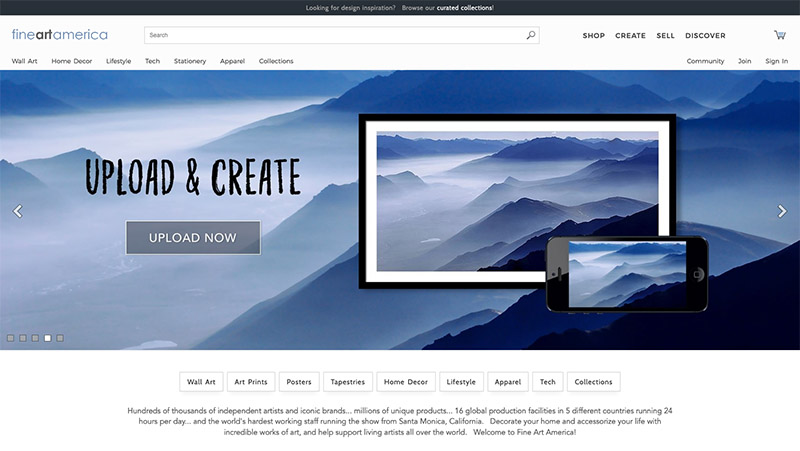
Fine Art America is a website dedicated to helping American artists get their start in the digital world. The company supports hundreds and thousands of independent artists, alongside iconic brands, and names that you may be well aware of.
The FineArtAmerica.com website is a melting pot of creative ideas. You can sell your art in the form of wall hangings and canvasses, or you can explore lifestyle products, home décor like pillows and throws, and even technology or stationary creations.
There are wood prints, framed prints, and canvas prints available, and the option to browse for artists by department or category. Plus, this company has 16 production facilities in 5 countries to help you bring your designs to life.
2. Artfinder
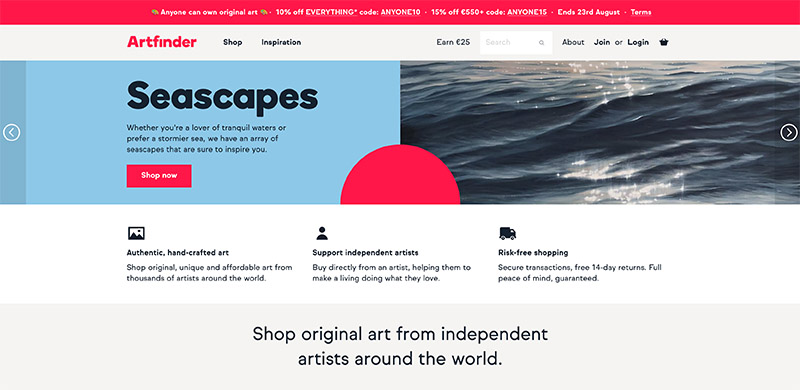
One of the top spots on the web for art collectors, Artfinder.com is a brilliant way to make your first steps into the art world. With offices in Miami and London, Art finder displays the art prints and work of thousands of artists across more than 100 countries.
Every piece you’ll find on this website is original, as there are no reproduction prints or posters allowed. The good news is that this art business accepts a wide range of different mediums, including digital art, printmaking, collages, and more.
The site, which first emerged in 2011, is quite exclusive. There’s a strict selection process that artists need to go through before they are allowed to join in online. However, you can start by simply submitting some of your best work along with a supporting statement.
3. Saatchi Art

Saatchi Art is one of the biggest names in the art environment for a reason. This incredible website was brought to life by the Charles Saatchi company. Although the company did sell to another owner in 2014, it still bears the iconic name today.
The audience for this online art gallery is huge. Graphic designers and digital artists across the world swarm around this amazing website, which has more than a million followers on social media. There are also a million people currently receiving the printed design catalogue from Saatchi Art.
You can set your own online store up on the website to sell prints and originals alike. Pieces listed on this website often range in price, all the way from one-off items for thousands of dollars, to prints that are available for much less.
The only real downside for this sell on-demand service is that Saatchi Art takes about 35% of your sale for their commission. However, they do arrange for a courier to collect the piece you’re selling and deliver it to your customer for that price.
4. Artpal
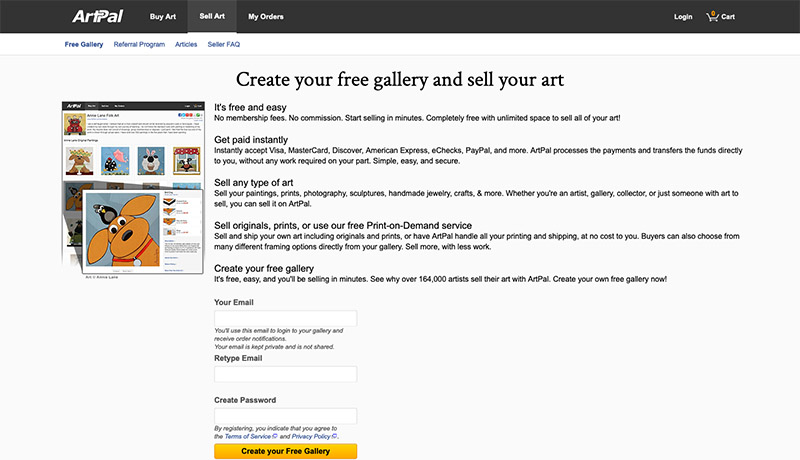
Artpal is a fun and convenient way to get your artwork online. The great thing about this site is that you can sell virtually any kind of art you can think of. This includes art for phone cases, handmade jewelry, sculptures, photography, and more.
There are no commissions to worry about and no membership fees. The environment is completely free and open to artists of all sizes. ArtPal also ensures that you get paid as quickly as possible too. There’s support for a wide range of payment options, which ArtPal processes and delivers straight to you.
This particular third-party art website also comes with its own print-on-demand service. This means that you can sell and ship your own prints without having to do too much extra work. It’s no wonder that ArtPal currently has more than 150 thousand artists online.
5. Minted
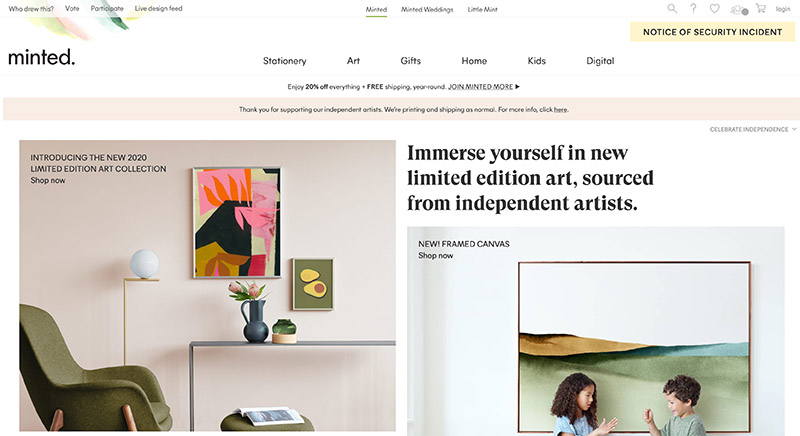
Minted is a beautiful website and an online community that’s perfect for art lovers. You can sell limited edition prints or one-of-a-kind handmade items through Minted, and you’ll get an excellent experience every time. As one of the best places for independent artists to increase their online sales, Minted has everything you need.
You can submit your designs for the community to vote on, and then Minted will showcase the pieces that have the most artistic merit. Minted doesn’t compromise on your artistic integrity by making any changes to your work. The company is there to ensure that you get the best possible results with the right substrates and printing processes.
Aside from getting a place to sell your art, you also get community support from Minted. The company is brimming with advocacy solutions for artists that need help getting recognized online. You can even compete for a chance to get your art showcased by the Minted team.
6. Etsy

Etsy is probably one of the most diverse places to sell your art online. You don’t need to create your own WordPress website or experiment with eBay to get started here. Artists can build a presence for themselves with no time, selling all of the different kinds of products that they choose.
With Etsy, there’s no limit to what you can create. You can design covers for an iPhone or take your art business to the next level by designing mugs, t-shirts, and art prints to share with the world. You could even bring all of the products that you made for your local art fair and list them on Etsy to improve your chances of getting that all-important sale.
Etsy is a popular choice for selling art online because it’s so easy to use and well-known. If you’re eager to get started online and you don’t want a complicated selling process, Etsy has you covered. The company also has a pretty reasonable fee structure. Whenever sell something with Etsy, there’s a transaction fee of 5%, plus the extra costs of shipping and gift wrapping.
7. Society6
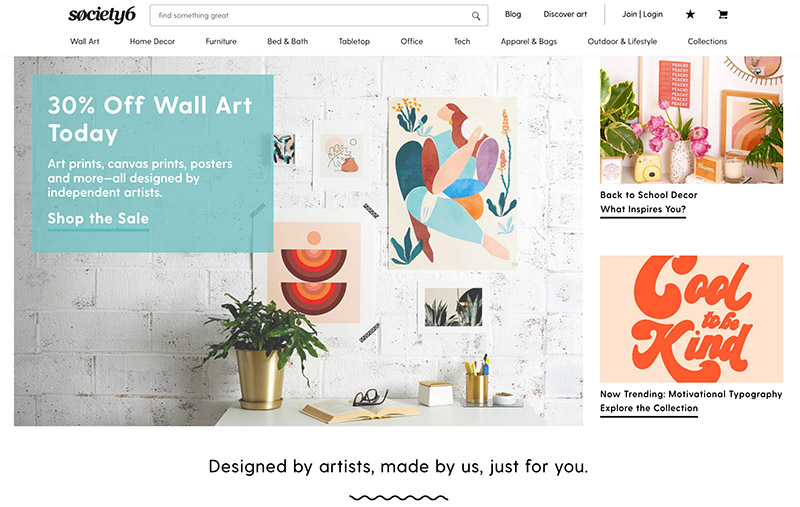
Society6 is a fantastic place for artists that want to sell reproductions and printed items. It works in a similar style to sites like Redbubble. Unlike other art marketplaces where you just sell your originals and prints, Society6 allows creators to expand their product portfolio. You upload your art and make it available in a range of formats.
With Society6, you have the freedom to create everything from mugs to phone cases. Plus, as you create your print on demand products, you don’t have to worry about losing control over your art. Society6 gives you complete ownership of your creations.
Plus, Society6 also handles the fulfilment process for you. That means that the company deals with things like making your art pieces and shipping them out to your customers. If you want a quick and easy way to sell your art in a wide range of different styles, this could be the perfect website for you.
8. Zazzle
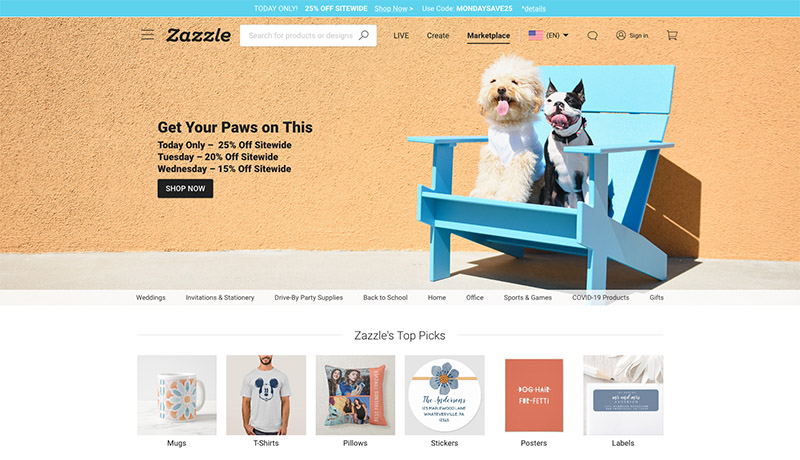
There are tons of great third-party galleries that you can use to sell art online, from ugallery, to eBay and more. Zazzle is one of the few locations that gives you the best of both worlds. You can become a creator and sell your products anywhere you like. Or, if you prefer, there’s another option too.
Graphic designers, artists, and other creative professionals can upload their artwork to the environment by making it into a print-on-demand variety of products. The great thing about Zazzle, besides all the freedom you get to upgrade your product portfolio, is that everything is easy.
You can set up an online store for free and set your own percentages regarding royalty to earn whatever you like. Zazzle takes care of all the hard work for you, so you can focus on building your brand and attracting new customers to your store. The site is one of the top performers in the industry right now for people who want a quick and easy way to sell a variety of products.
Decide How To Sell Art Online
Before launching your online art store, you first need to decide on how and what kind of art you’ll sell online. You have several options here which include:
- Selling your own art
- Selling reproduction prints
- Selling digital art
You can sell your art through an online supplier or via your online store.
Let’s explore these options below.
Deciding What Art To Sell Online
When it comes to selling art online, selling your own art is usually the best option. This allows you to set your own prices and charge more for your original work. But, unless you already have an audience of people interested in your art, you may have a harder time getting those initial sales. On the upside, there are a number of tactics you can use to market and promote your store which we will discuss below.
If you don’t have any original art to sell, you can sell reproduction prints of other artists. In this case, you are the online art curator responsible for marketing and promoting other artists as well as earning them a sale. As a curator, you’ll earn a commission on each sale but keep in mind that selling reproduction prints is more competitive than selling original pieces.
The third option for selling art online involves selling digital art. With digital art, there are no shipping and delivery costs to figure out as the artwork can be downloaded as soon as someone buys it. This is a cost-effective way of selling your art if you want to minimize your expenses. You can sell digital paintings and drawings as well as stock photos and digitized artwork. This option can also be used for selling reproduction prints of other artists.
Deciding How To Sell Art Online
Once you’ve decided what type of art you want to sell online, you need to decide how to sell art online.
The most obvious choice is to sell art via your online store. This gives you total control over your business as the entire process from creating the art through selling it, packaging it, and shipping it, is handled by you.
If you’re selling physical artwork, you’re also responsible for storing it until someone buys it.
The other option for selling your art online is through a third-party supplier. Using a third-party supplier is typically less risky than selling via your online store. When you opt for this method, you’ll be working with a print-on-demand or a drop-shipping service.
They will customize your prints and canvases and then sell them on a per-order basis. You will still need a website to showcase your art but the benefit of using a third-party supplier is that they will handle the entire process of packing and shipping your art once someone makes a purchase.
Decide On A Platform To Sell Your Art Online
No matter which method for selling your art online you’ve decided on, you’ll need a platform to create your store. The three popular platforms include Shopify, Squarespace, and Square Online Store. Let’s go over their features and pros and cons below.
Shopify
Shopify is a robust online eCommerce platform. You can create any type of store with it, including an art store. The biggest benefit of using a platform like Shopify is that you don’t have to worry about installing any software or any website updates or maintenance as all of this is handled by the platform itself. Some of the main Shopify features include:
- Dozens of free and paid themes that you can use to customize the look of your store
- Thousands of third-party free and paid apps for extra functionality which includes social sharing apps, accounting apps, inventory management apps, and many others
- Built-in SSL certificate so your customers can enjoy a peace of mind knowing their sensitive information is encrypted
- Responsive design so your customers can easily make a purchase even if they on their phone
- Detailed sales reports and statistics so you can see how your store is doing at a glance
- You can accept a variety of payments including credit cards and digital currencies
- Advanced abandoned cart recovery features so you can recover lost sales
- Flexible shipping rates including flat rate and free shipping
- And more.
As mentioned earlier, Shopify is a pretty robust eCommerce platform and makes it easy to launch your online store. The downside is that Shopify can get expensive if you decide to use premium apps for added features.
Squarespace
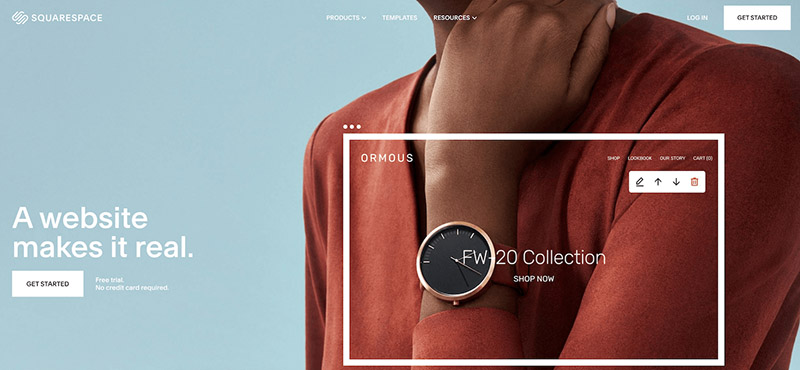
Another popular option for selling your art online is Squarespace. Squarespace is a great choice if you have a small inventory and are looking for a budget solution. Although you can sell unlimited products, Squarespace’s inventory management features are not as robust as Shopify’s which is the main reason why Squarespace is suitable for smaller stores.
It’s worth mentioning that Squarespace, like Shopify, handles all of the backend tech for you so there is nothing to install and not maintenance or updates to worry about. Main features include:
- Dozens of built-in, responsive templates that you can use at no extra charge
- Free custom domain when you sign up for a yearly plan
- Built-in SSL certificate that encrypts your customer’s information
- You can accept credit cards through Stripe and allow customers to pay via PayPal or Apple Pay
- Store and website analytics so you can see how many visitors your website is getting as well as how many sales and orders you have
- You can create customer accounts, accept donations, and create gift cards for your customers than can be used in your store
- Higher-priced Squarespace plans come with Google AdWords promotional credit so you can start marketing your store
Squarespace is easy to use and has an intuitive drag and drop builder that makes it easy to design your store. The biggest downside of Squarespace is that it’s not the best choice for stores that have a large inventory. That said, if you’re on a budget or only have a few items to sell at a time, Squarespace could be the best choice for you.
Square Online
If you’re on a budget, Square Online is a great choice to start selling your art online. This platform is free to use and you only pay when you make a sale. As with Shopify and Squarespace, there’s nothing for you to configure and install as you’re using a hosted platform. That means all the technical details are handled for you so you can focus on promoting your store.
Square Online stands out as it allows you to offer curbside pickup or local delivery to your customers. It also integrates with Instagram and Facebook so you can sell your art on those platforms. Main features include:
- Easy to use and intuitive builder to design your store
- You can accept all major credit cards, Square gift cards, Apple Pay, and Google Pay as your payment methods
- Comes with built in email marketing features
- You can generate sales coupons easily
Obviously, the biggest benefit of Square Online is that you can start selling your art for free which makes this platform a good choice if you’re on a budget. The downside is that the customization options are rather limited when compared to Shopify and Squarespace. You’ll also have Square branding in the footer of your website on the free plan so keep that in mind if you decide to go this route.
Sellfy
Sellfy is an eCommerce platform you can use to sell physical and digital products online and hopefully generate some income. This includes print-on-demand and subscription products too. One big plus is that you don’t need any technical experience to use Sellfy.
You can build your store directly via the platform or incorporate Sellfy's sales tools into your existing website.
Some of Sellfy's most notable features include:
- A free 14-day trial
- Three pricing plans to suit different sellers and budgets.
- No transaction fees
- You can customize the design of each web page by adding your logo, changing colors, and creating the layout you want
- Access to an online shopping cart
- Its responsive design means customers can interact with your Sellfy store via mobile, desktop, and tablets alike.
- Access to built-in marketing features, including email marketing and discount codes to entice and engage shoppers
- If you sell digital products, you can protect yourself from buyers sharing your creations by issuing unique download links with limited download attempts.
- Integrations with PayPal and Stripe are available, as well as Apple and Google Pay. There's also a list of local payment methods you can choose depending on which country you're located in and which country your buyer is located in.
As noted earlier, Sellfy is ideal for creators selling either digital products, print-on-demand items, or subscriptions.
However, the downside is that the more you want to sell and market yourself, the more expensive it gets. But on the plus side, it accepts all major payment providers, including Mastercard and Visa, with SSL secure payment systems in place. Although less famous than some of the better-known platforms in this review, it does, however, give creators the option to try before they buy.
Using Third-Party Marketplaces
It’s worth mentioning that you can also use third-party marketplaces like Etsy or Artsy. Platforms like these are very easy to get started with and there is no setup involved.
While they make it easy to start selling your art, keep in mind that they usually charge an extra transaction processing fee and may take a cut of your sales.
They are also limited in terms of customization features for your store. Another downside of using marketplaces like Etsy is that you’ll be dealing with a lot of competition which means you’ll have to work harder to stand out from other sellers on the platform.
Pros And Cons Of Using Ecommerce Platforms
By now, you should have an idea of how you want to sell your art online. Before you make your final decision, let’s go over the pros and cons of using eCommerce platforms like Shopify, Squarespace, and Square Online Store.
Benefits of these platforms include:
- Complete control over your store’s design thanks to built-in customization features and a nice selection of free and premium themes and templates
- Additional functionality such as integration with email or CRM platforms, the ability to sell on multiple platforms and channels at once is possible thanks to third-party apps and integrations
- Detailed analytics and sales reports and built-in SEO features so you have complete control over how your store displays in search engines.
- HIgher profits because you don’t have to pay listing fees or commissions
Disadvantages of using eCommerce platforms include:
- Bigger learning curve to set up your store
- Monthly or yearly fee for the store itself as well as for any additional third-party apps
Pros And Cons Of Selling On Third-Party Marketplaces And Galleries
We’ve mentioned earlier that third-party marketplaces are probably the easiest solution to get started selling your art online. There is no learning curve involved at all. All you have to do is sign up for an account, add the products to your store, and you’re ready to start selling.
On the downside, marketplaces like Etsy give you very little control over your store. That means, they can take your art down at any point in time or even take your entire store down if they decide you’re breaking their terms of service.
Another disadvantage is that you have no control over your store’s design which means it will be harder to stand out from your competition.
Now that we’ve covered the pros and cons of ecommerce platforms and third-party marketplaces, let’s go over the necessary steps for starting an online art store with Shopify.
How To Start Selling Art Online With Shopify
Shopify is a robust platform that’s easy to use even for complete beginners and it’s the best choice if you’re serious about making a living from selling your art. Below, you’ll find all the necessary steps to launch your art store with Shopify.
Step 1: Get Started With Shopify
The first step is to sign up for an account with Shopify. To get started, visit their website and enter your email address. You’ll then need to enter a password and a name for your store. Once you’ve filled out those details, Shopify will begin the setup process for your store.
You’ll need to enter your address and select the type of store you’ll launch. This information is needed so you can collect payments and after you have entered this information, you’ll see a button prompting you to enter your store.
Step 2: Get Familiar With Shopify’s Interface
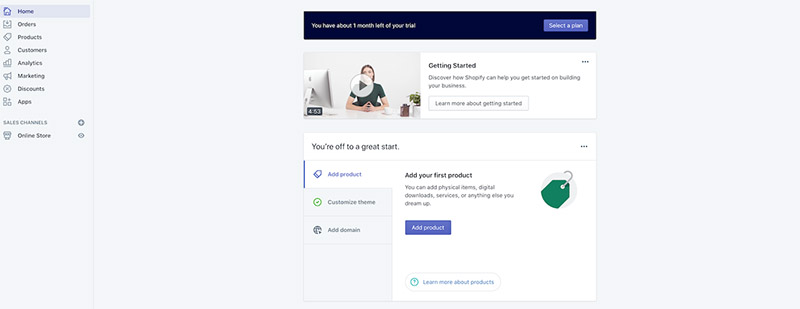
When you enter your store, you’ll notice a couple of helpful prompts from Shopify. They’ve included the Get Started video and the ability to immediately add your first product.
The left-hand side is where you can access all the settings for your store. Using the menu on the left, you can add your products, see store’s analytics, view a list of your customers and recent orders, and more.
You can also preview your store, add sales channels, and control how your store looks.
Lastly, your profile photo in the top right corner makes it easy to access your Shopify account, access the community forums, and Shopify’s support center.
Step 3: Setup Your Store Settings
Now that you’re familiar with Shopify’s interface, let’s take a quick look at the store settings. This is a good place to start to ensure you won’t forget any important settings before you start selling your products.
The settings panel allows you to configure your store details such as your address, contact information, and default units. You can also configure payment methods, add store locations, customize your checkout process, and more.
You’ll also use the Settings panel to manage your sales channels, upload files, and set up your store’s language.
Before officially launching your art store, be sure to configure your payment settings as well as your shipping and taxes settings. You’ll also want to add your terms and conditions and your privacy policy to make sure your art store complies with the legal requirements.
Step 4: Style Your Store
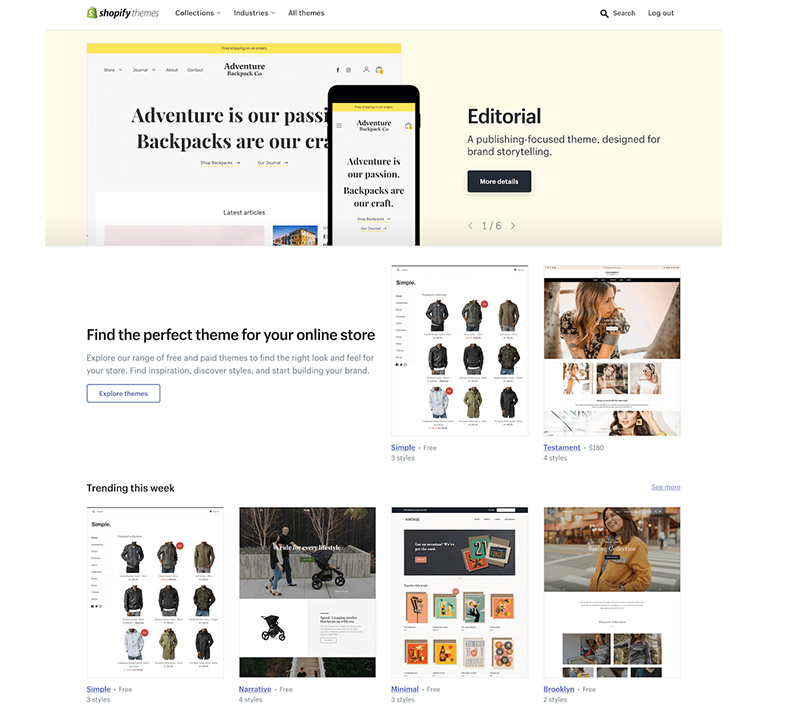
The next step in setting up your store is to style it. By default, your Shopify store will have a theme already installed. If you like the look of it, feel free to keep it but if not, you’ll need to choose a different theme.
Luckily, there are a number of free and paid themes that you can choose from and that are available on the Shopify theme marketplace. You can browse the themes by clicking on the Online Store icon and pressing the Themes option.
A new page will load where you’ll have the option to customize the theme that’s already active on your site or to explore other themes. Go ahead and explore other themes.
As you’ll notice, Shopify offers 73 themes total, 9 of which are free. Free themes are a good starting point if you’re not ready to invest in a premium theme. If you want a more professional look and more customization options, browse through their paid themes and find the one you like.
You’ll then need to install it by adding it to your theme library and clicking on the Actions menu. Choose Publish and the theme will be live on your site. You can customize how the theme looks by clicking the Customize button.
Once the theme customizer loads, you can add sections to your homepage and change colors, fonts, and more. If you want to style other pages, simply select the corresponding page from the drop-down at the top.
You can also see how your store will look on mobile phones and tablets and adjust your style settings accordingly.
Step 5: Create The Pages For Your Store
When you’re happy with how your store looks, it’s time to create the pages for your store. Your store will already have a homepage and a page where customers can see your art catalog. But there are a few more pages you need to add if you want your store to be successful. These include:
- About page where your customers can learn more about you and your art
- Store policies page where you can share your refund or exchange policy
- Contact page where customers can get in touch with you regarding a particular art piece
Shopify also makes it easy to add a Blog page which is a great way to market your products.
You can add a page to your site by clicking on the Online Store menu and pressing the Add page option. The page editor allows you to add the page title and content.
Below the editor, you’ll find the options to configure the SEO settings for that page which includes adding a meta title and a meta description. You’ll want to keep this short and use your keywords naturally to improve the chances of your store getting found by the search engines.
When you’re done adding the contents of your page, make sure the visibility is set to Visible on the right-hand side and click the Save button.
To add other pages to your site, simply repeat the steps above. It’s a good idea to set up your navigation menu at this point and add the most important pages to the main menu. To do this, click Navigation > Main Menu. Click Add item, choose Pages, and then select the pages you want to show. Save the menu.
Step 6: Add Your First Product
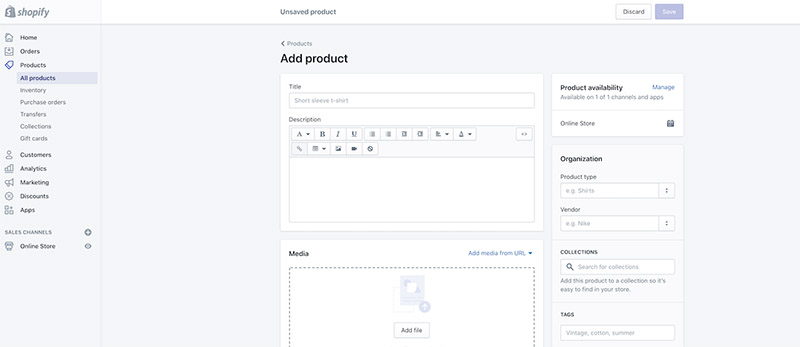
Adding your first product to your art store is easy. If you already have a list of your products stored in a .CSV format, you can import them by going to Products and clicking the Import link.
However, if you’re brand new to selling art online, you’ll need to follow the manual process of adding products to your store. Let’s cover this process below.
Click on the Add product button and start by entering the name and the description of your product. Below the product editor, you’ll have the option to upload product photos as well as add the price and the inventory details such as SKU number, quantity, and barcode.
The shipping section allows you to enter product dimensions, weight, and other shipping details.
Other product information includes product variants and SEO settings, product categories, collections, and tags.
After you have filled out all the details, press on Save and your first art piece is officially ready for sale.
To add more products, repeat the steps above. Keep in mind that you can use the Products section to manage product collections and purchase orders, view your inventory, gift cards, and more.
Step 7: Add Features With Apps

When you’re done adding all of your products, you can add extra features to your store with third-party apps from the Shopify App Store.
The apps you’ll find there are organized into various categories such as Store Design, Marketing, Reporting, Abandoned Cart Recovery, and similar. You can also search for apps using the search bar at the top.
To install an app, all you have to do is click Add app and then complete the installation process by reviewing the app’s permissions and clicking on the Install App button.
Be sure to set aside a few minutes to decide which functionality you want for your store and then install appropriate apps from the Shopify App Store. However, don’t feel pressured into completing this task immediately. You can always come back later and install the apps you want once you’re more familiar with selling your art and running your online store.
How To Present Your Art
By now, you should have a good understanding of how to set up your online art store with a platform like Shopify. However, there are few more things you need to consider before working on getting your first sale.
Art Photos
The most important thing you need to pay attention to is the way you present your art in your store. After all, if your product photos aren’t good, customers won’t be interested in buying the actual artwork.
For starters, you’ll want to make sure that the photos representing your art are high-quality and well-lit. They shouldn’t be blurry or grainy either.
Secondly, make sure that product photos are optimized for the web. This means you’ll need to save them in a JPG format and ensure they all have the same dimensions. You’ll have to play with the image compression settings to achieve the balance between a low file size and maintaining the quality of the image. Generally speaking, the smaller the file size the better, otherwise you run the risk of your website loading slowly.
Slow loading websites can hurt the user experience and your search engine rank which is why your product photos need to be optimized for the web.
You can use a tool like JPEGMini or TinyJPEG to reduce the size of your images without sacrificing image quality.
Categorize Your Art
Another way to make your art more presentable is to make sure to categorize and organize your artwork. This will make it easier for your customers to browse your store and find art pieces they are interested in.
You can categorize your images based on a technique you’ve used, type of artwork you’re selling, a theme such as portraits or black and white photos, and similar. You can also create art collections based on a period in your career or create a collection for featured artwork that displays your best work or limited edition pieces.
Make sure your customers can sort your artwork by price, material or size as well as shipping and delivery options. This will make their buying experience better and they will be more likely to return to your store.
Art Product Descriptions
Product photos play a crucial role in your store’s success but so do product descriptions. For starters, your product title and description should include keywords that your potential buyers would search for. However, include them naturally and don’t overdo it as using the keywords too much can be seen as keyword stuffing which can lead to your store being pushed down in the search engine result pages.
Intrigue potential buyers by writing a story about each piece of art as people relate to stories better. Consider including details such as why you created each particular piece, how did you decide on the technique or materials used in the artwork, who or what inspired you to create, and similar.
Don’t forget to include your product’s features such as dimensions, weight, material, delivery, and other details so customers can visualize your product better. Be sure to regularly check your product descriptions to ensure they are correct and up to date.
Another important tip for writing great product descriptions is to break up your copy and use short paragraphs and bullet points to make it easier to read.
Make sure to add alt tags to your product photos as this makes your product photos more likely to appear in Google’s image search results. They also help Google and other search engines understand your site better.
Finally, check your product descriptions for any spelling and grammar errors. You can use a browser extension like Grammarly to ensure your website copy is error-free to ensure your store doesn’t look amateurish.
Protecting Your Art
The last tip in this section is to consider how you’ll protect your art from copycats. Unfortunately, plagiarism and art theft happens in the online world just as it happens in the offline world.
While copycats and malevolent users will always find a workaround, there are several ways to protect your art online:
- Consider using a watermark on your product photos. You can use a tool like Lightroom or even Photoshop to add a semi-transparent watermark that can help deter copycats from downloading your images and displaying them elsewhere
- Find an app that allows you to disable the right-click in your store to prevent others from downloading your product photos
- Use hotlink protection to ensure people can’t embed them on their website.
- If you notice someone has stolen your artwork or product photos, get in touch with them first and explain you are the original artist. In some cases, you’ll find that people don’t really understand that using your art without permission constitutes copyright violation. You can politely ask them to take the photo or the artwork down. If that fails, file a DMCA takedown notice and get in touch with a copyright lawyer.
How To Price Your Artwork
Pricing your artwork is the trickiest part of selling your artwork. If you set the price too low, people will question the value of your work and if you set it too high, they won’t be inclined to buy it at all. While getting the price can be tricky, it’s definitely not impossible. There are several factors to consider when it comes to putting a price on your art.
First, you need to understand that the price of your art is dictated by the market’s demand and your particular niche.
It also depends on your previous sales history and your overall artistic experience. For example, if you’re a brand new artist, your art won’t command the same price as someone who’s already well-known and has an extensive sales history.
Another thing to consider when pricing your art is the style of your artwork and the materials and length of time used to create each piece.
In that respect, pricing your artwork requires upfront research so you can get an idea of where you should start. Consider finding an artist who sells artwork that’s similar to yours and use their pricing to guide yours.
Alternatively, consider working out your ideal hourly wage and multiply it by the time of hours it took you to create a particular piece of art. Be sure to include the cost of the materials used as well as shipping costs.
If you’re using multiple platforms to sell your artwork, keep your pricing consistent across all of them. Otherwise, you’ll have to deal with angry customers if they discover they could have gotten your artwork for cheaper elsewhere.
Shipping And Packaging Your Art
So your store is set up, you have great product photos, and you wrote amazing product descriptions. You’ve also priced your artwork accordingly and you’re feeling pretty confident about selling your art online. But before you announce the launch of your art store, there’s a few more things to configure.
For starters, you need to decide how you’ll package your art and the shipping method and courier you’ll use. This step is very important if you’re not relying on third-party suppliers to handle this process for you.
For starters, you’ll need to decide on the package size for your art. This will depend on the size and the type of your artwork. For example, paintings will require a different type of packaging than sculptures. If you sell a variety of artwork, you’ll need to have a variety of packaging options available to accommodate for different sizes and dimensions.
You’ll also want to ensure that you have protective material on hand. This includes bubble wrap as well as padding to ensure your artwork doesn’t get damaged.
A few general tips to keep in mind include:
- Use mailing tubes for artwork like prints and posters that are larger in size
- If you sell small prints, you can use cardboard envelopes
- If you sell sculptures, you’ll need to use boxes and bubble wrap or padding
Once you know how to package your art, it’s time to decide on the shipping courier that you’ll use for product deliveries. This can include companies like UPS or Fedex or USPS.
The first thing you’ll want to do when comparing these companies, is to check their pricing for various package sizes you know you’ll need. This will help you determine how much you need to charge for shipping.
Shopify makes it easy to connect to all of these services so you can easily display live shipping rates at checkout depending on the package dimensions and weight, your location, and the location of your customers.
Another option for shipping your products is to use a service like ShipStation. ShipStation is a fulfillment service that will store and pack your artwork for you. Once a sale comes through, ShipStation will also handle the shipping for you which means you don’t have to deal with it.
After you have sorted out your shipping model and your product packaging, you can use the Shopify’s Settings panel to configure the shipping options for your store.
Shopify allows you to configure different shipping rates for domestic shipping and international shipping. You can also create custom shipping profiles for certain groups of products or for different locations.
Here are a few examples to consider:
- You can configure flat rate shipping which means that no matter how big or how heavy the package is, shipping will always cost the same. This method is a good choice if you sell art that’s usually the same size and weight.
- Weight-depending. You can choose this option if you sell a lot of different artwork that varies in weight
- Local pickup or store pickup. If you have a local brick and mortar art store, consider including this option as this allows you to build a personal relationship with each buyer.
Once you’ve configured your shipping rates, you can move on to configure your package sizes based on the criteria we mentioned earlier and to customize your packing slips.
The last step in the shipping configuration settings is to enter your shipping couriers. As mentioned earlier, you can connect your store with services like UPS and Fedex as well as various fulfillment services.
Connecting your store with shipping couriers will allow you to use carrier calculated shipping. This means that your shipping cost will be automatically calculated based on their rules and regulations. The cost of the shipping will vary on the weight and the size of the package. This method is useful if you sell art that has different sizes and dimensions.
It’s worth mentioning that the more shipping options you offer, the better your customers' experience will be. They will be able to choose the method that’s most convenient for them, both in terms of price and the delivery time.
Insuring Your Art
Insurance is not the most exciting thing to think about as you get ready to sell your artwork online but keep in mind accidents do happen. The right insurance can go a long way towards protecting your art as well as you.
In most cases, companies like UPS and FedEx will have limited insurance that you can take advantage of. However, there’s nothing stopping you from using a dedicated insurance company to make sure your art is covered in case of damages.
The more valuable your art is, the more coverage your insurance policy should provide. Don’t skimp out on this for the sake of saving money as potential artwork damages cost you more in the long run.
Launch Your Art Store
With all of the technical and set up details taken care of, it’s finally time to take the next step and launch your art store.
Start by previewing the store and making sure everything looks and works as expected. Click on each product to ensure product descriptions are correct and photos have been uploaded correctly.
Check each page for typos and ensure everything important is laid out in a clear and understandable fashion.
Finally, test the checkout process and make sure it’s easy to go through. When you’re done checking everything, head to Online Store > Domains. You’ll need to buy a domain for your store that your customers will use to browse your site.
Choosing a domain for your store is an important step. If you already have an art store, the obvious choice is to see if your store name is available as a domain name and use that.
If that’s not the case, you have a couple of options:
- Use your own name as the domain name. This will allow you to build a truly personal brand for your art
- Use a more general domain name that relates to your artwork.
As far as the domain extensions go, .com is the most popular option but it’s getting harder and harder to find a good domain name that’s available with that extension. A few other popular options include .store, .art, and .me.
Once you’ve settled on a domain name, purchase it through Shopify or if you already have a domain name, connect it from your third-party provider. You can then publish your store by upgrading to a paid Shopify plan. Shopify offers three main plans to choose from:
- Basic Shopify — this plan allows you to sell unlimited products and invite up to 2 staff members to your store. It includes all the necessary features such as SSL certificates, manual order creation, 4 locations, discount codes, abandoned cart recovery, 64% shipping discount, and more. This plan costs $29/month.
- Shopify — this plan includes everything from the previous plan as well as extra features such as USPS Priority Mail Cubic® pricing, 5 staff member accounts, 72% shipping discount, and professional reports. This plan is available for $79/month.
- Advanced Shopify — this plan includes everything from the previous plan and offers the lowest credit card processing fees as well as the ability to have 15 staff accounts and up to 8 locations. It also offers 74% shipping rate discount and advanced sales reports. This plan costs $299/month.
The Basic Shopify plan is the best choice if you’re just getting started. If you already have a substantial body of work and you’ve been selling your art in person, the Shopify store is a good option as you’ll be able to get more professional reports and lower processing fees. Lastly, choose the Advanced Shopify plan if you have an established presence in the art community accompanied with a successful brick and mortar art store.
How To Promote Your Online Art Store
Now that your store is live, your primary focus should be marketing and promoting your store. This step is crucial if you want to attract visitors and hope to convert them into customers. After all, just because your store is live, that doesn’t mean people will know your art is ready to be purchased.
You need to tell them and that’s where marketing comes into play. There are several ways to market your store which include:
- Building your email list
- Being active on social media
- Creating content to promote your store
- Using Pinterest to pin and promote your products
- Streaming your art process
- Promoting your online store with offline marketing methods
Let’s go over each of these methods more in-depth below.
Building Your Email List
The most important marketing tip is to start building your email list from day one. This will allow you to capture the information of visitors who are interested in your art but aren’t quite ready to make the purchase. By capturing their email address, you can send them news and updates about your store and art and nurture the relationship until they are ready to buy.
A good way to build your list is to offer something in exchange for their email address. You can offer them a discount code or a special offer such as buying one print gets them half off on a second one. Alternatively, you can offer a smaller version of your artwork as a phone or computer wallpaper for free in exchange for their email address.
Once you’ve decided on what you’ll offer as an incentive for someone to sign up for your email list, you’ll need to sign up with an email service provider. A few popular choices include SendinBlue and Klaviyo. Both of these allow you to start building your list for free and they can be embedded into your store pretty easily.
If you prefer to keep everything in one place, you can use Shopify Email to email your subscribers. This is a new service from Shopify that’s currently free for all users and makes it easy to create email campaigns that match your store’s design.
On top of that, there are numerous apps on the Shopify App Store that will help you create newsletter sign up forms that integrate with various email marketing providers.
Being Active On Social Media
Another effective method for promoting your art store (and the fastest way to get the word out) is to have an active presence on social media platforms. There are many platforms to choose from but the best course of action is to actively participate where your ideal audience hangs out.
Keep in mind you don’t have to be active on all the platforms. Start with one or two and get familiar with them and then expand into other platforms.
Some things you can post include behind-the-scenes sneak peeks into new artwork, special offers, sale announcements, fun memes related to your niche, questions that will help you learn more about your audience, and similar.
Mix plain text posts with images and videos to keep your accounts more engaging. Comment on your followers posts, answer their questions, and actively engage with your audience. This will help you establish a personal relationship with potential customers and help you create a loyal community of fans.
The most popular platform among artists is Instagram due to its highly visual nature. Instagram also provides you with ample methods for promoting your art. Firstly, you can promote your art in your Instagram feed. This gives you a perfect opportunity to build a visually engaging Instagram profile.
You can also enable shoppable posts that make it easy for your followers to click through to your Shopify store and make a purchase.
Secondly, you can use Instagram Stories to share behind-the-scenes posts of your creative process.
Lastly, you can use IGTV video to answer customer questions about your products or to showcase different art pieces you have available for sale.
Creating Content To Promote Your Store
You can also promote your store by making use of the blogging features Shopify offers. You can post blog posts that explain your creative process as well as share tips on how to display your artwork in their home or office. You can also create gift guides that feature your artwork.
The nice thing about blogging is that it tells the search engines that your site is regularly updated with fresh content which means they will scan it more often. On top of that, search engines love sites that are regularly updated.
In addition, each blog post you create is another opportunity to include keywords relevant to your art which means more chances for your store to show up in search results when potential buyers are looking to buy art online.
Using Pinterest To Pin And Promote Your Products
Most people think Pinterest is a social media platform but in reality it’s a search engine. This means that you don’t have to worry about engaging with other users outside of pinning their content. What matters on Pinterest is optimizing your pin descriptions and titles with keywords that are related to your products.
This is a good platform for any artist as it allows you to easily promote your products simply by configuring rich pins for products.
Once you enable this option and set it up, people can be taken directly to the product page on your site and complete their purchase.
The best way to get started on Pinterest is to sign up for a free business account and create boards that your ideal audience would be interested in. This can be boards like home decor or interior design. You should also create a dedicated board where you will pin your artwork.
Pin your content but remember to pin content from other pinners as well. Aim for 80/20 ratio in terms of content distribution and be sure to create several pins for each product in your store as this will give your products more chances to be discovered, not to mention different pins will appeal to different people.
Streaming Your Art Process
When it comes to marketing, video is one of the best ways to promote your products. Video posts get more engagement than text and photo posts and 72% of customers would rather learn about a product or service by way of video.
When it comes to video marketing, live streaming is a great way to promote your art. You can easily stream your art creation process to get your audience interested in your artwork and motivate them to make a purchase.
What makes live streaming so great is that you can quickly and easily build a relationship with your audience. They can get to know you and get a feel for your art which will make them more likely to want to support you.
The most popular live streaming platform is Twitch. Twitch is primarily geared for gamers but they do have a dedicated section for creative streamers so you can fit right in.
If Twitch is not your cup of tea, consider using the second most popular search engine — Youtube.
Your third option for live streaming is Facebook which touts over 2 billion users so you’re bound to find your audience on there.
Keep in mind that if you decide to go this route, you’ll need to invest in a more powerful computer as well as a decent webcam and a microphone to ensure your audio and video quality aren’t subpar.
Another thing to keep in mind with live streaming is that you’ll need to establish a regular schedule and show up often if you want to build a loyal audience.
If your budget is limited or if you don’t have a lot of free time, live streaming may not be the best option to market your art store.
Influencer Marketing, Contests, And Giveaways
If you want to gain traction quickly, influencer marketing, contests, and giveaways are a good way to get noticed.
With influencer marketing, you’ll be paying someone with a large following and established presence on social media to promote your art for you. This method works well on Instagram. You can pay for the influencer to give you a shoutout or you can arrange for an Instagram takeover where you post on their account for a day.
Remember that you’ll need to establish a relationship with the influencer first as well as ensure that their audience would be interested in your art, otherwise this method won’t bring you good results.
You can also use contests and giveaways to promote your store. These methods work best after you have grown your following and have an established presence on your favorite social media platform.
It also works great when used in conjunction with influencer marketing as this exposes you to a larger audience.
You can give away a smaller print of the original artwork or you can go big and give away an original piece of art in its original size.
Be sure to set up rules for your giveaway and specify how the winner will be chosen. You’ll also need to ensure your contest or giveaway is following Instagram’s official giveaway terms and conditions and any local regulations.
Promoting Your Online Store With Offline Marketing Methods
Just because you have an online store, that doesn’t mean you can’t use offline marketing methods to promote it. Some of these methods will require you to spend money while others can be done at no extra cost to you other than time.
The easiest way to promote your product is to add your store’s website address to your email signature.
You can also create brochures that showcase your artwork and include your store’s website so people can check it out.
A few other offline methods include:
- Traditional newspaper or billboard advertising
- Posting flyers in your neighborhood
- Adding a decal to your car with your store’s address
- Sending your customers handwritten thank you notes to capitalize on word of mouth marketing
- Asking your friends and family to help you spread the word about your online store
Remember to get creative and experiment with different marketing methods to see which one brings you the best results.
Promoting Your Art Store With Paid Advertising
The last marketing method that you can use is paid advertising. This method can work wonders when done well and can bring you sales and customers rather quickly. However, it’s also the most expensive marketing method as the ad costs can be quite high so opt for this method if you have a large marketing budget to work with.
There are various online advertising platforms that you can use to promote your product. The most popular ones include Google AdWords, Facebook Ads, and Pinterest Promoted Pins. Shopify also makes it easy to create ads for Facebook and Snapchat directly from your store’s backend.
With Google AdWords, you get access to their entire partner network which means your ads can be seen everywhere on the web. Depending on the type of ad you choose, you can have your ads seen on search engine result pages, on partner websites, in Youtube videos, and more.
Facebook advertising allows you to promote your products not only on Facebook but also Instagram. You can create text ads as well as carousel and video ads which typically bring more engagement. Facebook also has a very robust ad manager that allows you to really fine-tune your audience based on their demographics and interests.
Given the constant changes in Facebook’s algorithm, some claim ads are the best way to ensure your audience actually sees your posts.
Lastly, Pinterest Promoted Pins are relatively new when it comes to paid advertising so this option is still the most affordable one. Promoted Pins work similarly to other paid advertising methods — typically, you’ll pay per click to have your pin seen by more people.
No matter which paid advertising option you choose, you’ll need to make sure that your product pages are optimized for each platform. You’ll want to use the same imagery and branding to provide them with a consistent experience and ensure your audience that they have landed on the right page.
You’ll also want to keep track of your ad performance and let your ads run for at least a week before making any changes to the ad copy.
Conclusion
Selling your art online is not difficult once you have a clear understanding of all the steps that are involved in the process. In this guide, we’ve laid out the entire process for you and explained the key concepts of selling art online. All that’s left to do now is to sign up for Shopify and follow our tutorial to set up and promote your store. Happy selling!

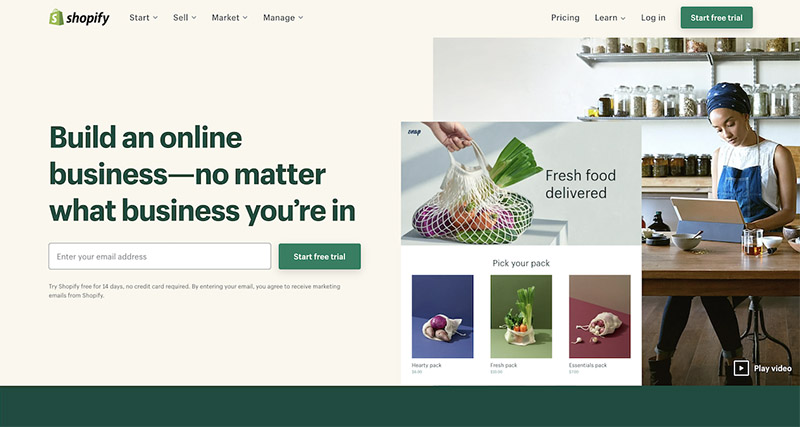
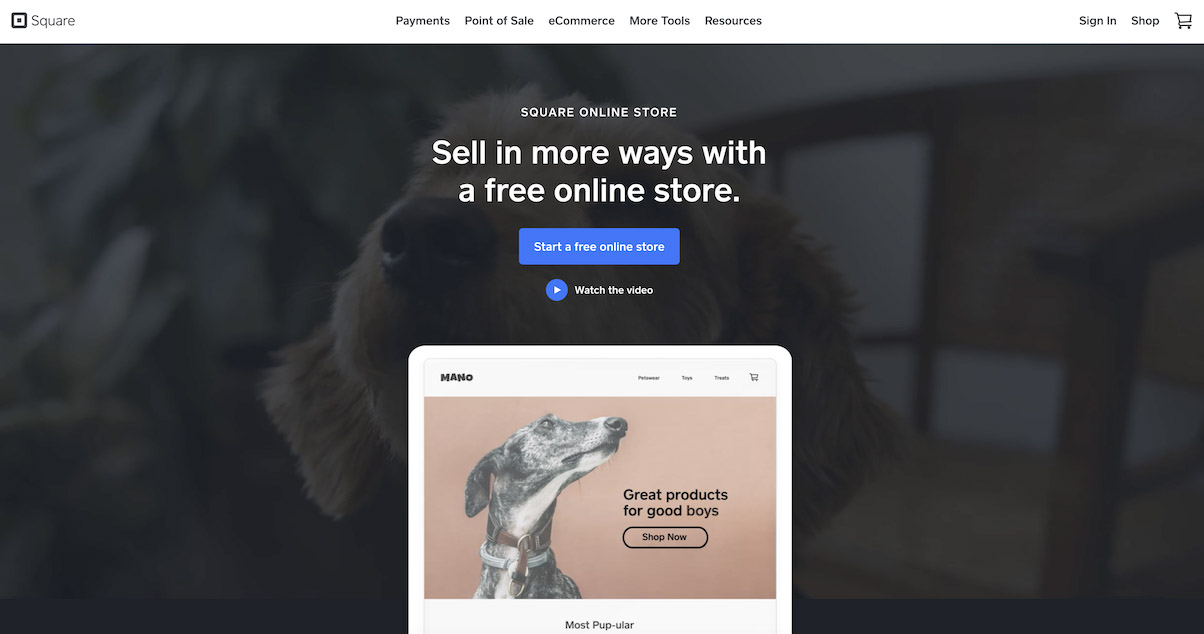

Am vandut un tablou prin Saatchi Art.
Am urmat toti pasii indicati de ei si am completat toate documentele date de ei.
A venit DHL-ul comandat de ei sa ridice coletul si documentele. Pana aici totul bine si frumos. Dupa ce a plecat curierul cu coletul de la mine am inceput sa primesc mailuri de la o madama cu titlul de Agent Tranzit Export, care a inceput sa-mi ceara sa completez acte aditionale. In continuare OK. In timp ce pregateam restul de acte cerute pe la al doilea mail, primesc un alt mail in care imi spune ca, citez:
“Avand in vedere ca sunteti persoana fizica, nu aveti voie sa comercializati. Scopul comercial/vanzare nu se accepta” PUNCT!
Concluzie nu pot sa-mi vand arta ca persoana fizica, trebuie sa fiu persoana juridica.
Stie cineva cum suna legea legata de exportul operelor de arta contemporana, de catre autorul insusi?
A mai patit cineva asa ceva?
Sunt plina de nervi, ajutor, va rog!
I sold a painting through Saatchi Art.
I followed all the steps they indicated and filled out all the paperwork they gave me.
The DHL came to pick up the parcel and the documents. So far so good. After the courier left with the parcel I started receiving mails from a lady with the title of Export Transit Agent, who started asking me to fill in additional documents. Still OK. While I was preparing the rest of the requested documents on the second mail, I receive another mail in which she tells me that, quote:
“Since you are a natural person, you are not allowed to trade. Commercial/sales purposes are not accepted” FULL STOP!
Conclusion I can’t sell my art as a natural person, I have to be a legal person.
Does anyone know what the law on the export of contemporary art by the author himself sounds like?
Has anyone else experienced this?
Hello Noemi,
I hope you managed to find a solution for this. As far as I know you should be able to sell as an individual.
That was really helpful!
Thanks!
Danke für den ausführlichen und informativen Bericht wie man Kunst online verkaufen kann. Sehr interessant. Bisher hatte ich Erfahrung nur mit Auktionen.
You’re welcome Dia!
Saatchi Art is one of the most respected names in the art business with over 65,000 artists from around the world selling their artworks on their platform.
👍👍👍